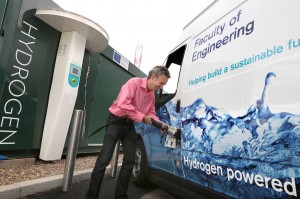Hydrogen fuel cell electric vehicles will take center stage at this week’s LA Auto Show. Three companies — Toyota, Honda and Hyundai — will unveil prototypes of new hydrogen fuel cell electric vehicles and announce details of their rollout plans for 2014 and 2015. Fuel cell vehicles may not be as well-known as hybrids and plug-in electric vehicles, but they are a vital part of the solution to reduce pollution and oil use from transportation. These vehicles have been promised for some time, so it’s exciting to be on the cusp of having fuel cell vehicles in new car showrooms.
Fuel cells turn hydrogen into electricity & water
Hydrogen fuel cells join the advantages of clean, efficient electric vehicles with the convenience of fast refueling. The fuel cell combines hydrogen gas stored in a tank with oxygen from the air to produce electricity and water. The electricity from the fuel cell then powers an electric motor, similar to today’s plug-in electric vehicles. And like battery electric vehicles, there is no smog-forming or climate-changing pollution from the vehicle’s tailpipe.
However, just as producing electricity to charge a plug-in vehicle creates emissions, hydrogen also generates emissions. Hydrogen made today from natural gas gives about the same total emissions per mile as charging a plug-in vehicle with electricity generated from natural gas. But hydrogen can also be made from renewable sources like biomass and solar power, so in the future hydrogen-powered vehicles can be much cleaner than gasoline-burning vehicles.
Fill ’r up
Another advantage of hydrogen fuel cell vehicles is that they can be refueled at a filling station in a short time. This means that drivers who would rather not plug in a battery electric car can still use a clean electric motor to get around. The filling time is about the same as a gasoline vehicle, about 5-10 minutes for a 300-mile range.
Of course, to take advantage of a hydrogen car, the filling stations need to be available. California is building the first wave of hydrogen filling stations with 28 currently operational or under construction and 68 planned for use by 2016. Starting in the Los Angeles and San Francisco metro areas, these stations are designed to fuel the first 20,000 fuel cell vehicles.
Bigger and brawnier EVs
Adding more range or power to a battery electric vehicle requires more battery cells, but adding cells increases costs. In fuel cell vehicles, the amount of energy stored can be increased without a proportional increase in cost because only a larger hydrogen tank onboard is required. The practical result is the ability to make an electric-drive SUV-style vehicle with the same cargo capacity and range as a gasoline version. In real-world tests in southern California, a fuel cell-powered Toyota Highlander SUV demonstrated a range of more than 400 miles range and the equivalent of 69 miles-per-gallon efficiency.
On an even larger scale, the Bay Area’s AC Transit runs clean hydrogen fuel cell buses by our Berkeley office many times a day. These buses have logged over 750,000 clean miles in the last 13 years, showing that fuel cells are a workable solution for electrifying large vehicles.
Teammates, not competitors
Battery electric, fuel cell electric, and more efficient gasoline vehicles have often been portrayed as competitors. However, this isn’t a winner-take-all situation because these technologies are complementary. Plug-in electrics can take advantage of the existing electric infrastructure and smaller electric cars can be especially efficient and cost-effective. Hydrogen fuel cells are a good option for larger vehicles, longer distance driving, and for drivers without a spot to recharge. And since many gasoline-powered vehicles will be sold in the coming years, more efficient conventional vehicles will also play a key role in transportation. All of these technologies are part of our strategy to cut projected oil use in half and tackle climate change. I’m excited that with the addition of hydrogen fuel cell vehicles, some car buyers will soon have more clean vehicles to choose from at the dealership.
David Reichmuth is a senior engineer in the Clean Vehicles Program, focusing on oil savings and vehicle electrification
This article was originally published on the Union of Concerned Scientists blog The Equation. Reproduced here with permission










